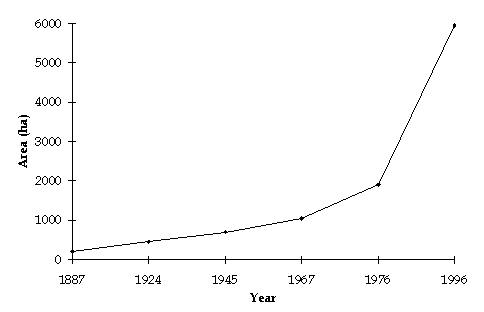Executive Summary Of Environmental Baseline Report - Section 3 Natural Resources Capital Stock
|
SECTION 3 NATURAL RESOURCES CAPITAL STOCK
| 3.1 |
LAND USE AND LAND SUPPLY |
| |
|
| |
| 3.1.1 |
Baseline Resources and Key Pressure |
| |
|
| |
Land suitable for development in Hong Kong is extremely limited due to topographical constraints and existing development. Future development will need to focus increasingly on urban redevelopment and the Urban Renewal Authority has been established to spearhead such initiatives. Both the area of land reclaimed from the sea and the rate of reclamation of land (hectares per year) have increased significantly since the mid 20th Century. As of 1996, a total of 5,950 ha of land had been reclaimed (Figure 3.1a). However, 38% of the land area of Hong Kong is covered by Country Parks (which are managed for conservation, recreation and landscape purposes) and Special Areas (which have particular conservation importance). Designated land of conservation importance also includes 64 SSSIs, the Mai Po Marshes Inner Deep Bay Ramsar Site and three restricted areas.
Figure 3.1a: Cumulative Area of Reclaimed Land in Hectares

There are also three Marine Parks and one Marine Reserve which occupy around 1.5% of Hong Kong's marine waters and are designated to protect and conserve the marine environment. Pressure for future development will manifest itself through further reclamation, development of land in a natural state and urban renewal. The balance of these outcomes will be affected by the strength of the planning system in terms of protection of designated natural and conservation areas and land allocations, as well as considerations such as generation of construction and demolition material from urban regeneration projects.
Land use and supply is also under pressure from pollution. Over 4,000 sites have been identified as potentially contaminated through the Government's Black Spot Task Force and even designated areas such as Country Parks are impacted by the adverse effects of visitor pressure including littering and fly tipping, hill fires and disturbance to habitats. The current stock of land supply in Hong Kong is not sufficient to sustain current levels of development in the medium to long term and alternatives to continued development of natural areas will need to be identified. Weighing the importance of conserving an area against the benefits of developing it should be based on a holistic valuation of all capital stock functions provided by land resources.
|
| |
|
|
|
|
     |